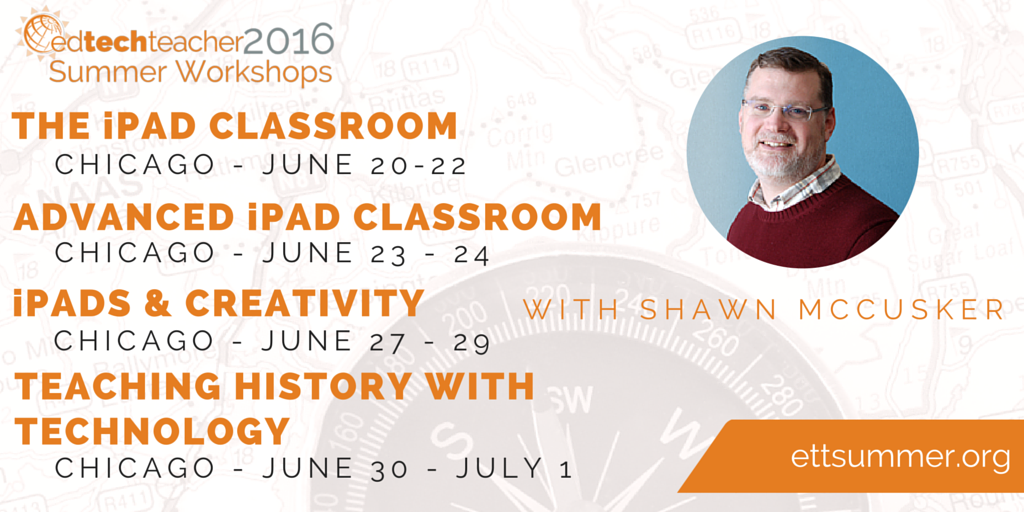This post first appeared on Education Week’s EdTech Researcher blog.
In 2006, my principal called me into her office and asked about rumors that I had been using student phones in class. It was my first year at the school, so I hesitated before acknowledging that I had. Her next reaction surprised me: she gave me free reign to use them as much as possible so long as I shared the results. She felt that we could not hold back the coming tide of technology from our classrooms. As it was just a matter of time before the ban on mobile devices in schools would end, so began my journey with mobile technology in the classroom.
Last year, after teaching for two years in a 1:1 iPad classroom, I accepted a position at a school that had not yet made the move to 1:1. Though plans were in the works to do so, for one year, my students would not have devices. While much technology would still be readily accessible in the form of carts and labs, using it in class would be more incidental and not a daily occurrence.
After a year of planning lessons without the daily presence of student devices, here are the differences that I have faced and what I look forward to in the coming year.
1. Greater Student Control of Content
I quickly realized that once my students were in possession of devices, the lecture format that had comprised a good portion of my teaching would never be the same. When students CAN fact check what you say, they do. This was difficult until I realized that it was exactly what I wanted them to do; fact check a narrative. Rather than fearing the commentary, I constructed class around it. Soon, most of the content that we discussed came from student contributions rather than my notes or the textbook. In discussions, when an unknown arose, it became a class norm for students to fill the void.
With limited access to technology, classroom resources are frequently provided by the teacher and unknowns are often left for the teacher to resolve. While incorporating student contributed content can be a priority, the timeliness and volume can’t compare when students do not have devices. Even with the greatest level of care and professionalism, this represents a filter on class content. Next year, I will prioritize the creation of a classroom that is once again fueled by sources, ideas and concepts generated by the students.
2. Multiple Perspectives and More Than One Correct answer
When all of the world’s knowledge is available, it can be hard to reach a single conclusion. Though initially a struggle, I ultimately came to believe that the debates to construct and defend such arguments made for outstanding learning. These lessons were far more dynamic, engaging and social than previous ones. The activities allowed students to understand the way that others constructed their ideas and regularly required them to articulate their positions.
3. Dynamic Projects
The nature of class work is different without technology. More often than not, completed work is collected and exists in piles of paper. It is then graded and returned.
In technology rich classrooms, the variety of tools allows students to select the medium which best conveys their idea. Because of the unique nature of the work, these class products generated energy and commentary. Students were more excited to share what they had made and more eager to consume the work of their classmates. In fact, my new policy is that I will not assign work that I am not interested in grading. This year, without these tools available in class, it has been a challenge.
4. Feedback
One eye opening realization was the speed and volume of feedback in a 1:1 classroom. With devices, delivering feedback to students became more efficient and timely because once I posted a comment online my students were alerted and able to respond. There was no need to wait for class work to be physically handed back.
Much more powerful, however, was the volume of student feedback that was shared as my comments became just one of many. I found it helpful to construct my feedback by referring to the thoughtful comments that classmates had shared which established the class norms to define quality. This year, I have been hungry for those thoughts, and they have been harder to harvest. I regularly use Exit Slips and methods like “Fist or Five,” but I am eager to recreate the depth of commentary and to once again have the rich feedback that helps me generate more meaningful learning.
5.Student Centered Learning
The ability to add content, an environment that allowed for students to defend their interpretation of information, and dynamic student constructed projects moved students to the center of learning. It was not long before I felt comfortable asking students to help me construct learning objectives and design complete units. For example, my unit on World War II transformed into an NCAA style research tournament presided over by a jury of seniors. I would never have planned such an activity by myself, but it was highly effective and meaningful for the class.
Having technology available for a day or several days can help to move students to the center of learning, but giving them possession of those tools makes truly transformative student centered learning a reality. I am eager for the opportunity to once again harness these powerful tools for learning on a daily basis.
Learn more from Shawn this Summer in Chicago:
Or the rest of our great staff in Atlanta, Baltimore, Boca Raton, Boston, LA or San Francisco: View the Full Course Catalog at ettsummer.org



